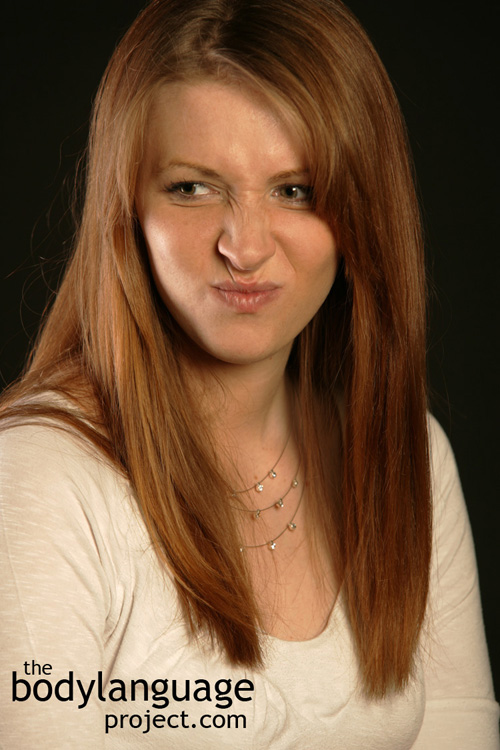Body Language of The Undershaker Handshake
 Cue: Undershaker Handshake (The)
Cue: Undershaker Handshake (The)
Synonym(s): Shortshaker Handshake (The)
Description: This handshake is so quick, it’s actually offensive. It lasts merely seconds where the hand is quickly grabbed then released or tossed aside. Sometimes it even lacks any pumping action at all.
In One Sentence: The undershaker is person who covets their own personal space and wants to keep their distance as much as possible.
How To Use it: When you dislike someone, you may try to keep physical contact brief to tell them that it makes you uncomfortable. A quick shake followed by moving backwards, eyes averted, says that you are not willing to interact with them or give them the time of day.
Context: General.
Verbal Translation: “I don’t like what you are selling and I feel like you are trying to take advantage of me so I’m going to drop your hand as quickly as possible so I can get on with my own agenda.”
Variant: See Country Handshake (The), Cold Dead Wet Fish Handshake, Double Gripper Politician Handshake or Double Hander (The), Short Grabber/Finger Grabber Handshake, Oddball Handshake, Palm Up, Palm Down and Palm Even Handshakes, Stiff Arm And Thrust Forward Handshake, Death Grip Handshake, Wrench Forward Handshake, Undershaker Handshake, Wrist Hold Handshake, Wrist Hold Handshake and Upper Arm Grip Handshake, Limp Fish Handshake, Teacup Handshake, Arm Twister Handshake (The), Firm handshake, Fist Bumping.
Cue In Action: The door-to-door salesman managed to make his way inside the house with a slick sales pitch, but the more the homeowner learned the more he disliked the idea. He didn’t know how to get out of the deal as he had already agreed to a sample. When finalizing, the salesman put his hand out to shake and being polite the homeowner did, but he released after just one pump and tossed the shady salesman’s hand aside abruptly.
Meaning and/or Motivation: Someone who shakes hands like this is showing indifference and suspicion.
It is common when someone feels that you are trying to sell them something they aren’t at all interested in buying, or trying to get them to do something they aren’t willing to do.
Other times they are trying to signal that you are intruding on their ground and that no agreement will be made. It’s probably best to respect their wishes, as their initial impression shows that you have come on far too strong.
Other times the undershaker is demonstrating his high need for personal space or lives in a location where physical contact isn’t normal.
Cue Cluster: Some who uses the undershaker handshake will give clues that he does not want to be there. He will turn his head and torso away, move his feet toward the door, will keep his head nods brief, if he nods at all, will take a step back and will only feign listening. This person wants to leave.
Body Language Category: Defensive, Dislike (nonverbal), Distancing or moving away, Escape movements, Indicators of disinterest (IOD), Intention movements, Negative body language, Rejection body language, Suspicious body language, Social touching.
Resources:
Aström, J ; Thorell, L H ; Holmlund, U ; D’Elia, G. Handshaking, personality, and psychopathology in psychiatric patients, a reliability and correlational study. Perceptual and motor skills 1993, Vol.77(3 Pt 2): 1171-86.
Beaulieu, Catherine. Intercultural Study of Personal Space: A Case Study. Journal of Applied Social Psychology. 2004 34(4):794-805.
Chaplin William F.; Phillips Jeffrey B; Brown Jonathan D.; Clanton Nancy R.; Stein Jennifer L.; 2000. Handshaking, gender, personality, and first impressions Journal of personality and social psychology. 79(1): 110-117.
Dolcos, Sanda ; Sung, Keen ; Argo, Jennifer J ; Flor-Henry, Sophie ; Dolcos, Florin. The power of a handshake: neural correlates of evaluative judgments in observed social interactions. Journal of cognitive neuroscience. 2012 24(12): 2292-305.
Dolphin, Carol Zinner. Beyond hall: Variables in the use of personal space in intercultural transactions. Howard Journal of Communications. 1988. 1(1): 23-38.
Fisher, J; Rytting, M and Heslin, R. 1976. Hands touching hands: affective and evaluative effects on interpersonal touch, Sociometry 39: 416–421.
Frumin, Idan; Ofer Perl; Yaara Endevelt-Shapira; Ami Eisen; Neetai Eshel; Iris Heller; Maya Shemesh; Aharon Ravia; Lee Sela; Anat Arzi and Noam Sobel. A Social Chemosignaling Function for Human Handshaking. eLife 2015. 4:e05154
DOI: http://dx.doi.org/10.7554/eLife.05154.
http://bodylanguageproject.com/articles/shake-hands-share-human-scent-curious-case-hand-sniffing-body-language/
Greenberg, Carl I. ; Firestone, Ira J. Greenwald, Anthony G. (editor). Compensatory responses to crowding: Effects of personal space intrusion and privacy reduction. Journal of Personality and Social Psychology. 1977. 35(9): 637-644.
Graziano, Michael S.A. and Cooke, Dylan F. Parieto-frontal interactions, personal space, and defensive behavior. Neuropsychologia. 2006. 44(6): 845-859.
Gueguen, Nicolas. Handshaking and Compliance With a Request – A Door-to-door Setting. Social Behavior and Personality. 2013. 41(10): 1585-1588.
http://bodylanguageproject.com/articles/handshakes-lead-compliance-study/
Greenbaum, Paul ; Rosenfeld, Howard. Varieties of touching in greetings: Sequential structure and sex-related differences. Journal of Nonverbal Behavior. 1980. 5(1): 13-25.
Holt, Daphne J ; Cassidy, Brittany S ; Yue, Xiaomin ; Rauch, Scott L ; Boeke, Emily A ; Nasr, Shahin ; Tootell, Roger B H ; Coombs, Garth. Neural correlates of personal space intrusion. The Journal of neuroscience : the official journal of the Society for Neuroscience. 2014. 34(12): 4123-34.
Hiemstra, Kathleen M. Shake My Hand: Making the Right First Impression in Business With Nonverbal Communications.(Brief Article)(Statistical Data Included). Business Communication Quarterly. 1999. 62(4): 71.
Jeffrey D. Fisher; Marvin Rytting; Richard Heslin. 1976. Hands Touching Hands: Affective and Evaluative Effects of an Interpersonal Touch. Sociometry, 39(4): 416-421.
Okken, Vanessa ; Van Rompay, Thomas ; Pruyn, Ad. Room to Move: On Spatial Constraints and Self-Disclosure During Intimate Conversations. Environment and Behavior. 2013. 45(6): 737-760.
Lipsitz, Rebecca (2000). “A Gripping Start.” In Scientific American (September), p. 32.
Morris, Desmond (1994). Bodytalk: The Meaning of Human Gestures (New York: Crown Publishers).
Mcelroy, James C. ; Morrow, Paula C. Personal space, personal appearance, and personal selling. Psychological Reports. 1994 74(2): 425(2).
Mcgurk, Barry J. ; Davis, John D. ; Grehan, John. Assaultive behavior personality and personal space. Aggressive Behavior. 1981. 7(4): 317-324.
Pease, Barbara and Allan Pease. 2006. The Definitive Book of Body Language Hardcover. Bantam.
Sanda Dolcos; Keen Sung; Jennifer J. Argo; Sophie Flor-Henry and Florin Dolcos. The Power of a Handshake: Neural Correlates of Evaluative Judgments in Observed Social Interactions. Journal of Cognitive Neuroscience. 24; 12: 2292–2305.
http://bodylanguageproject.com/articles/handshake-open-body-language-powerful-nonverbal-effect-brain/
Stewart, Greg L. ; Dustin, Susan L. ; Barrick, Murray R. ; Darnold, Todd C. Zedeck, Sheldon (editor). Exploring the Handshake in Employment Interviews. Journal of Applied Psychology. 2008. 93(5): 1139-1146.
Spezialetti, Brian D. Do’s and don’ts for winning the job interview. (laboratory technicians). Medical Laboratory Observer. 1995. 27(7): 51-53.
Wesson, David A. The handshake as non-verbal communication in business. (marketing technique). Marketing Intelligence & Planning. 1992. 10(9): 61(6).
Werner, Carol ; Brown, Barbara ; Damron, Gary Steiner, Ivan D. (editor). Territorial marking in a game arcade. Journal of Personality and Social Psychology. 1981. 41(6): 1094-1104.







